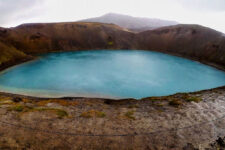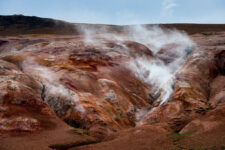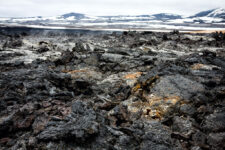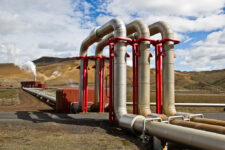Krafla is one of the most striking and active volcanoes in Iceland. Its energy feeds the largest geothermal power plant in the country.
Krafla volcano
Krafla’s crater belongs to a larger volcanic system – with the same name – and is situated north of the Mývatn lake, in northern part of the island. The oldest rocks of the central Krafla volcano date back to as much as approx. 300 000 years ago. However, most of the rock is a bit “younger” – formed between 200 000 and 100 000 years ago.
D
riving around the Myvatn area it is hard to imagine the sheer size of Krafla. The small crater with its Viti lake, on many maps marked as Krafla, is just a really tiny fragment of the whole volcano. Standing near Viti we need to realize that practically ALL of the hills that we see around us are INSIDE the main caldera of the Krafla volcano…
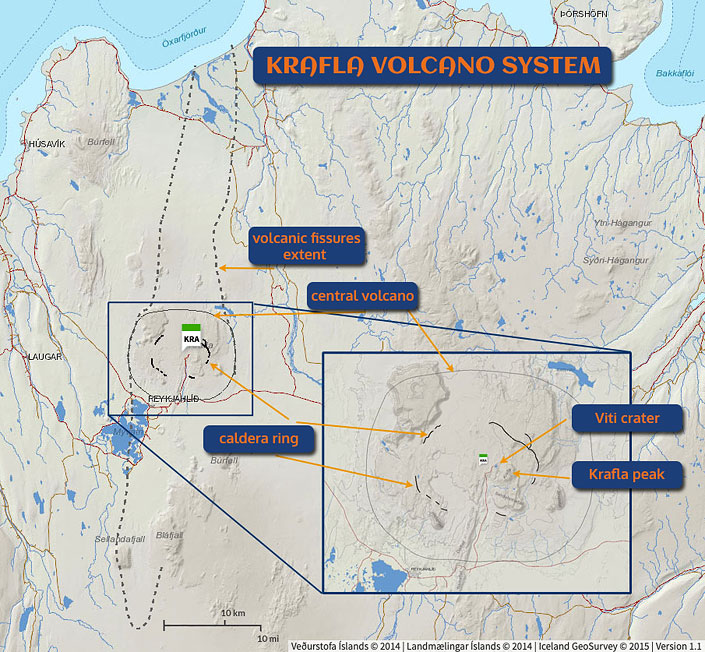 Krafla does not resemble what we are used to call a volcano. It is not a lone, tall, steep mountain with a blunt, cut off tip. Quite the opposite – Krafla is sprawling and the telltale volcano shape has been lost in numerous eruptions and due to erosion. The circle formed by the main caldera (to simplify things a bit: the top ring of the crater) has a diameter of approx. 10 km (!), while the underground structure of the main volcano is as much as approx. 20 km wide, and the rift zone (where numerous eruptions have occurred through smaller craters) stretches as far as 100 km from north to south.
Krafla does not resemble what we are used to call a volcano. It is not a lone, tall, steep mountain with a blunt, cut off tip. Quite the opposite – Krafla is sprawling and the telltale volcano shape has been lost in numerous eruptions and due to erosion. The circle formed by the main caldera (to simplify things a bit: the top ring of the crater) has a diameter of approx. 10 km (!), while the underground structure of the main volcano is as much as approx. 20 km wide, and the rift zone (where numerous eruptions have occurred through smaller craters) stretches as far as 100 km from north to south.
T
he tallest point of Krafla today is 818 m and it is a mountain about 1 km east to the Viti crater and lake. But practically all the hills we see from the lake are inside (!) Krafla’s main caldera…
Krafla is considered to be a moderately active volcano. Its largest explosive eruption (mainly gases) occurred about 110 000 years ago, while the largest effusive eruption (mainly lava) about 12 000 years ago. It formed the Gjástykkisbunga lava field north of what is today known as the Viti crater. In the Holocene (the current geological epoch lasting approx. 12 000 years) 29 eruptions have been documented.
Even though from the point of view of volcanology one might say that Krafla does not erupt often, two of its last explosions happened in modern times. These eruptions caused massive damage and were rather well documented. The first one was called Myvatn fires, lasting above 5 years in 1724-1729. And the second one, Krafla fires, lasting 9 years, took place in 1975-1984, which is fairly recent. Due to these two eruptions Krafla is rather infamous as an unpredictable and threatening volcano.
Krafla is responsible for most of the landscape north of lake Myvatn. It is hard to get to the very top but you can see a striking lava field, Leirhnjukur, on its sides and a small lake Viti nested in one of the lateral craters. An equally amazing Hverfjall near the lake is also part of the Krafla volcanic system.
To learn more on the history of volcanic eruptions as well as the landscape around Krafla and Myvatnlake see a separate guide here Geology of the Myvatn area.
Viti crater and lake
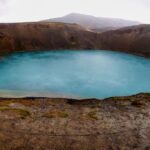
Viti crater w. Krafla peak in background
Viti’s distinguishing characteristic is its milky-blue water, accompanied by the unmistakable slight aroma of sulphur. The whole place, small as it is, has its very special charm.
A
bout 70 km south, still in the volcanic system of
Askja, there is another small volcanic lake called Viti. You can even swim in it…
Leirhnjukur – crater with a beautiful lava field

Leirnhjukur
According to scientists, the geothermal area of Leirhnjukur, along with the nearby Namafjall Hverir, takes off gases from Krafla’s volcanic chamber, lowering pressure inside it and preventing serious ground deformations that can be often observed in the vicinity of other volcanoes.
It is true that there are more lava fields in this area, but Leirhnjukur is different in that it’s unusual and varied in its structure. The results of volcanic activity one can encounter here are very peculiar and diversified in form.
Colorful rhyolite rocks and volcanic lakes are scattered between still fresh patches of lava. One can easily trace lava flows and subsequent stages of moss and lichen growth as well as various shapes formed by solidified magma. This rugged and at the same time very colorful landscape makes this whole area rather “otherworldly.” Definitely it’s worth comparing it to a nearby lava field called Dimmuborgir and this geothermal area Namafjall Hverir. The Leirhnjukur lava field combines many of the most exciting elements of the other two places.
Leirhnjukur is perhaps the best place to see an impressive lava field from up close, if you are not planning on traveling into the Interior.
All around Leirhnjukur, on an area no larger than 1 km2 (the so called small loop is a 1-hour walk), we can see a multitude of rock formations: rhyolite hills, solidified lava fields, rifts and open lava tunnels, still steaming fumaroles (or rather solfataras or moffetas), bubbling mud puddles, and even a hot lake (but you mustn’t bathe in it!). The area’s signature feature is the smell of sulphur pervading the air. If you have a few hours, you can even do a 5-hour hike here.
In
many places you won’t see marked trails. The length of your hike depends on your own preferences, abilities and appetite for breathtaking views (and, of course, the weather).Always remember to stay safe – you are strolling inside the caldera of an active volcano…
The area surrounding Leirhnjukur is sheer rock, scree and often muddy sand. There are boardwalks in some places – for nature conservation purposes and for tourists’ convenience. Still, you can freely choose where to go and for how long. In some places you can, and even have to, go off the boardwalk. But always be careful. Never touch rocks from which steam pours, and better yet – don’t approach them, especially if you encounter steaming sands. Do not climb the rocks or go into lava tunnels. It is good to have sturdy hiking boots, even though for the boardwalks even flip flops would be enough (but I don’t recommend them!). On a rainy day nearly the whole area may be very slippery.
Kröflustöð – the largest geothermal power plant
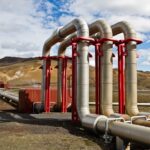
Krafla Power Plant
Kroflustod has total capacity of 63 MW. When compared to coal-fired power plants, for example in Poland, it is rather small. However, this one is a geothermal plant, which makes it huge in its category, and definitely the largest in Iceland. It has 33 boreholes and can generate 500 GWh of electricity annually. Kroflustod comprises two 30-megawatt units with a double pressure inlet and double-flow turbines. The energy is fed to it from 17 high-pressure and 5 low-pressure production boreholes.
The red buildings with a massive cloud of white steam floating above them and a characteristic “gate” made of pipes running over the road are a unique and memorable sight.
The development of the Krafla Power Plant was a pioneering endeavor, persistently encumbered by political debates, volcanic eruptions and technical problems. Its construction started in 1974 with sometest boreholes. Due to volcanic activity in the region, the work was slow going. The plant was finished in 1977, and commissioned a year later. In 1996 another steam turbine was installed, bringing the plant to its full capacity. Initially, the facility was owned by the government, however, in 1985 it was bought by Landsvirkjun — The National Power Company, which has been operating it ever since.
The power plant hosts an exhibition on geology, geothermal power and its history in Iceland. It is open on weekdays, 12:30-15:30 and weekends – 13:00 to 17:00.
Practical tips
Krafla area – Viti and Leirhnjukur – is a paid parking zone. The cost (in 2025) is 800 ISK ($6) for a regular passenger car (more for a minibus or coach).
You can pay through the EasyPark app (but not through Parka). In the app, it is zone 665 (‘Leirhnjukar & Viti’). The zone includes both the parking lot at the Viti lake and the parking lot at the start of the trail to Leirhnjukur, as well as the scenic parking lot, opposite the one at Leirhnjukur, on a small hill.
We pay once, to use the zone, rather than separately for each parking lot.
- The Krafla viewpoint is at the end of the asphalt section of road 863, which turns off road 1, to the north, 5 km east of Reykjahlid and lake Myvatn. You can admire the Viti crater and lake from here, while the neighboring car park (approx. 1 km earlier – southwest of Viti) is the starting point of a trail that will take you to the amazing lava field formed by the Leirhnjukur volcano.
- Parking area near Leirhnjukur is located approx. 1 km north from Krafla Power Plant (Kröflustöð) – it is small but free of charge. The trail from the car park to the main part of the lava field stretches for about 1 km, but beautiful views start much sooner than that.
- From the Leirhnjukur car park you can take 2 hiking routes. The small loop takes about 1 hour to walk, while the big loop could take even up to 5 hours. If you want to explore the area thoroughly, plan your hike for about 2 hours.
- Naturally, if there is snow on the ground, the colors of rocks may be concealed making whole area slightly less spectacular.
- The best view of Krafla Power Plant can be caught while going towards Leirhnjukur and the Viti crater. You need to leave road 1 and turn north into road 863, near Namafjall Hverir, approx. 5 km east from Reykjahlid and lake Myvatn. After about 7 km you go past the plant and under the “gate” made of pipes.
Photos of Krafla, Viti, Leirhnjukur and Kröflustöð




